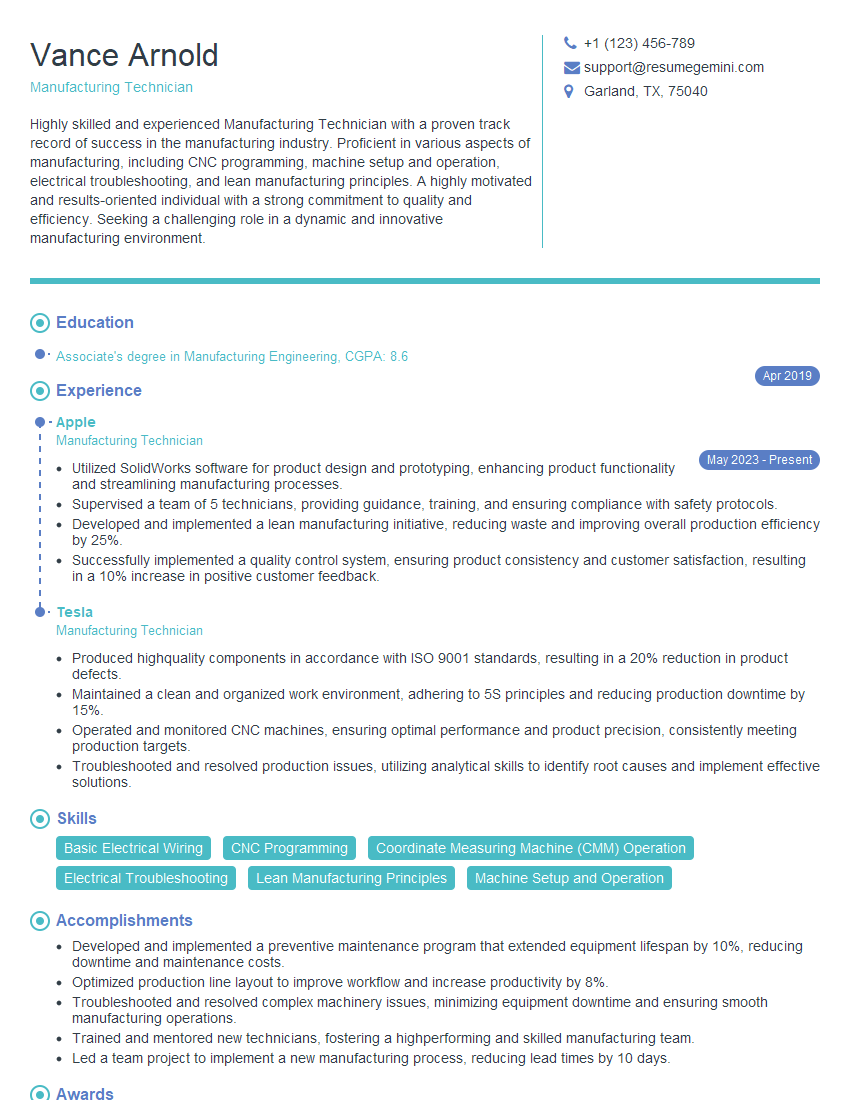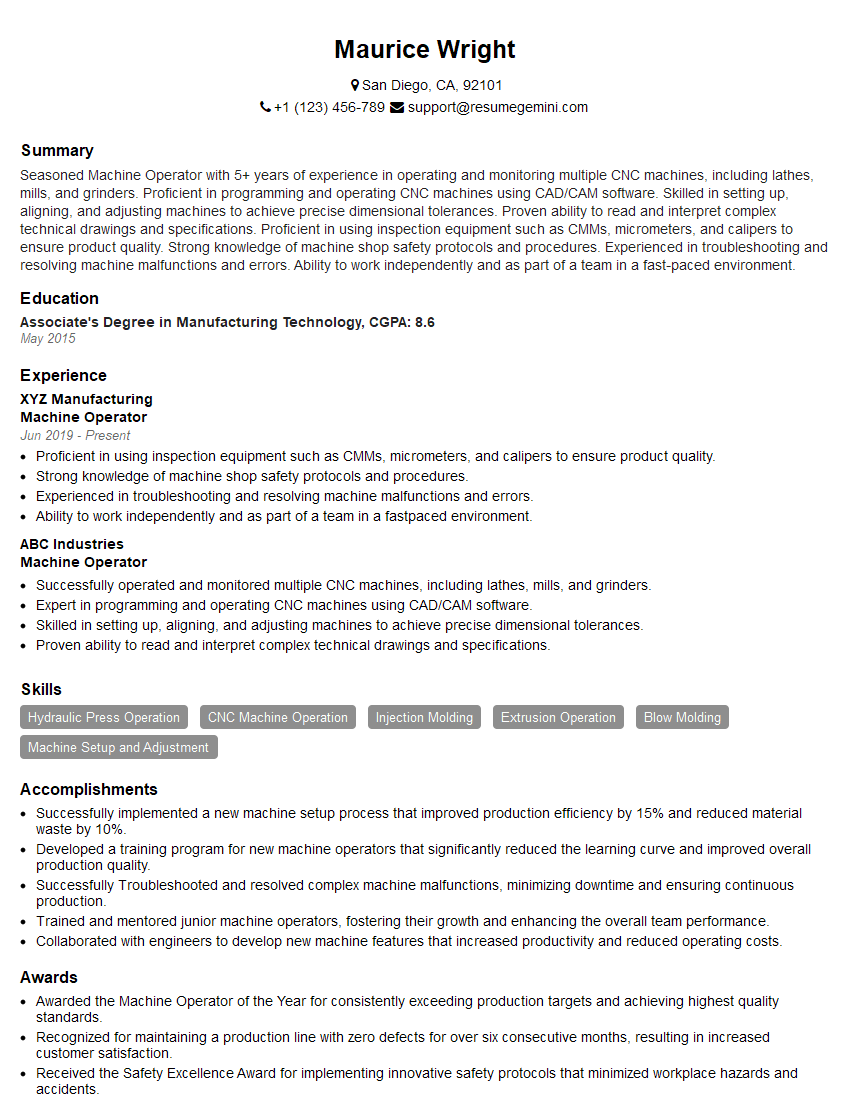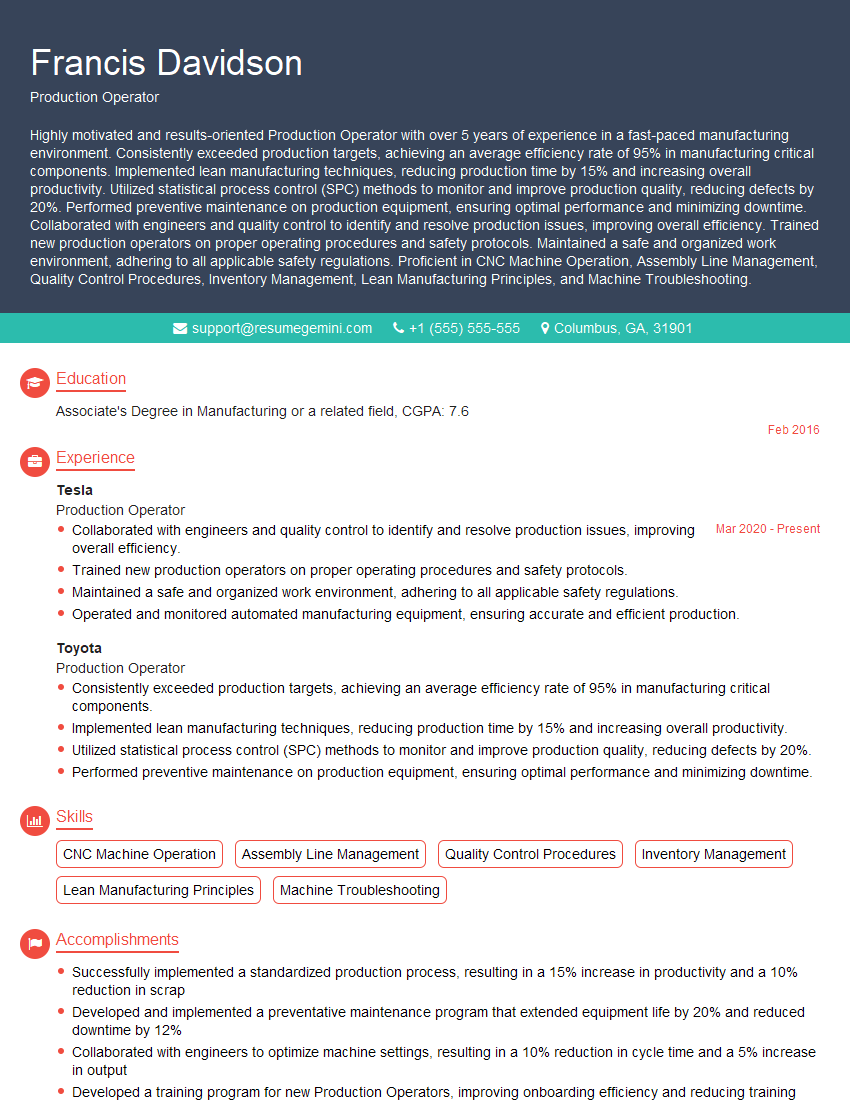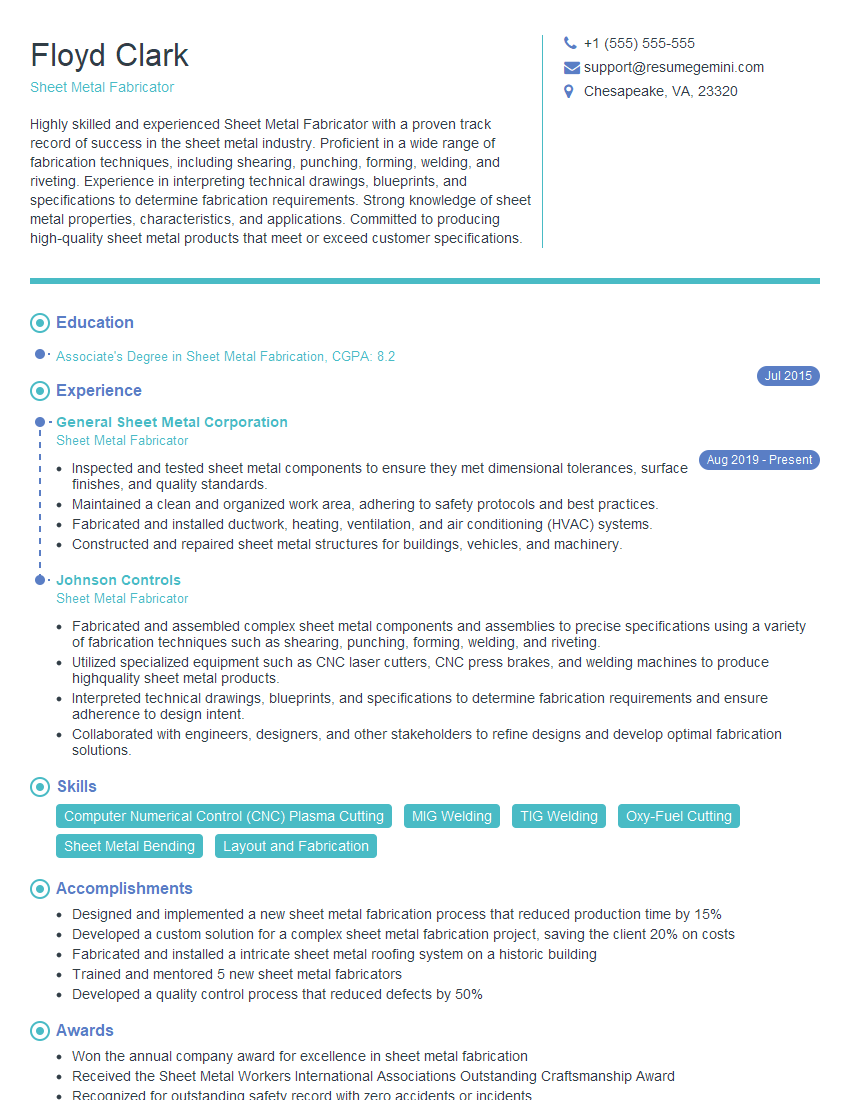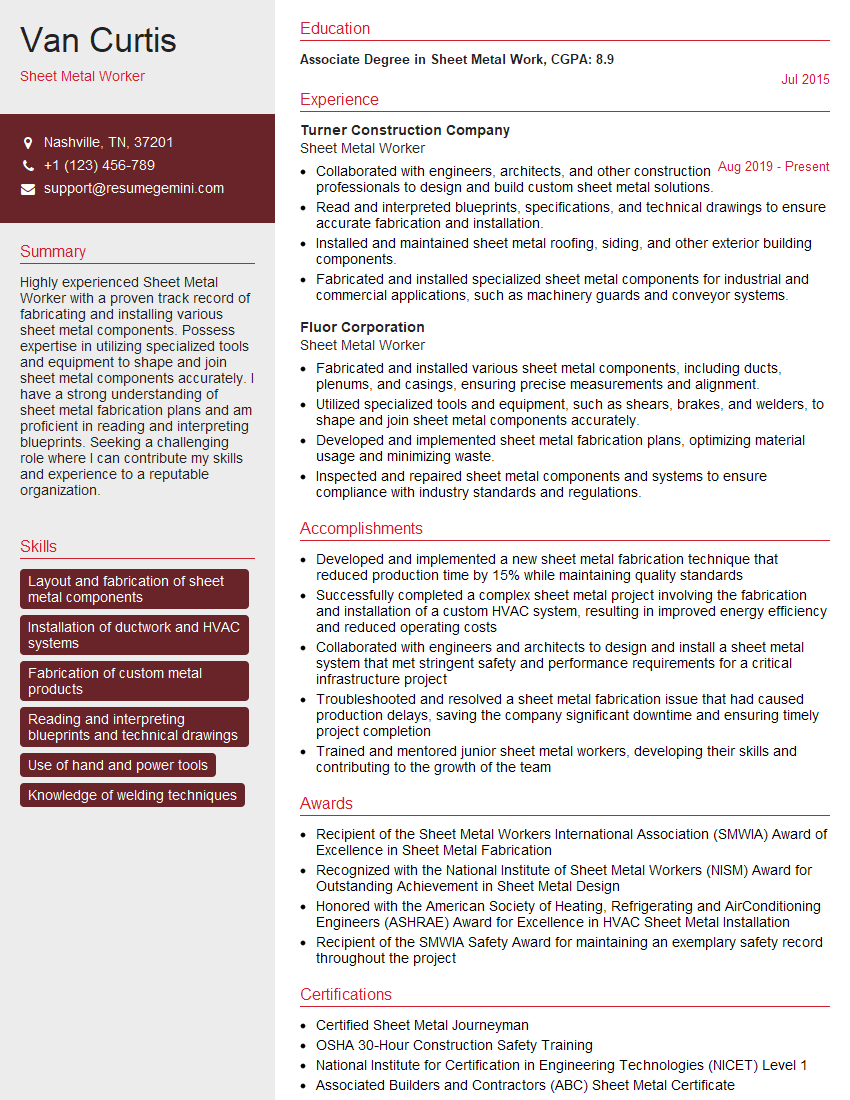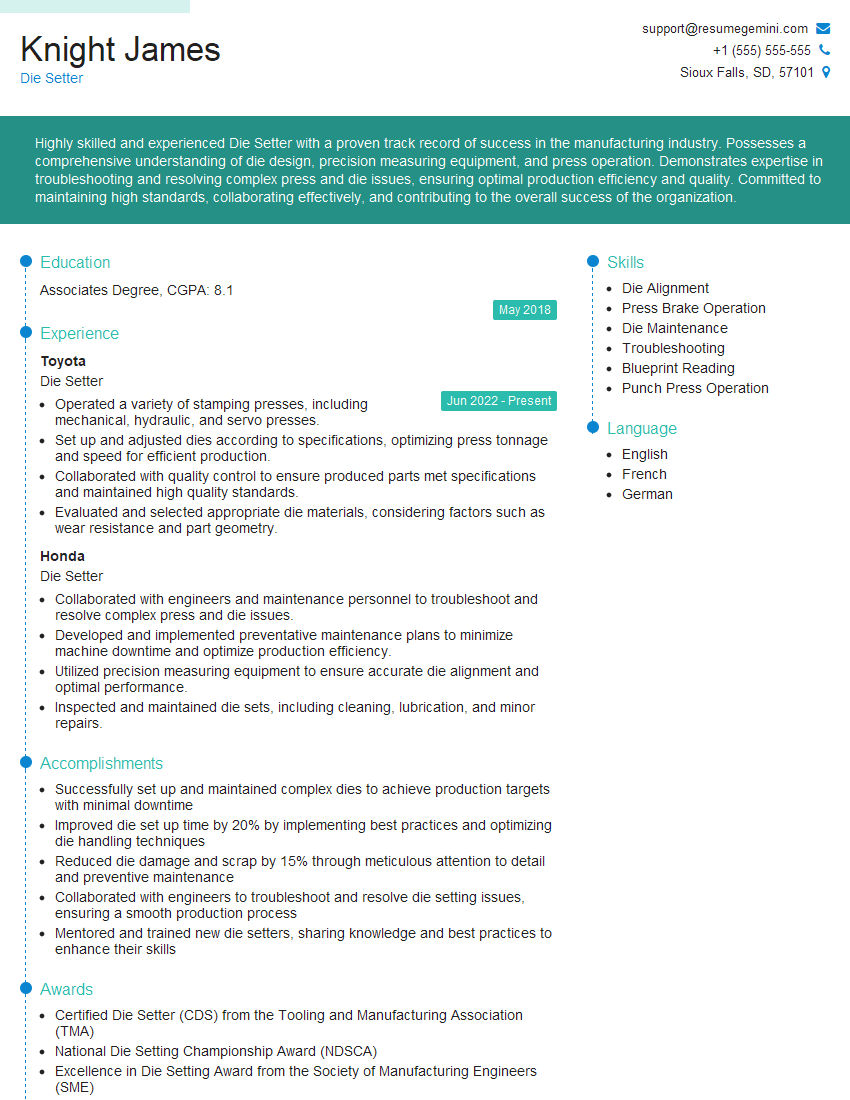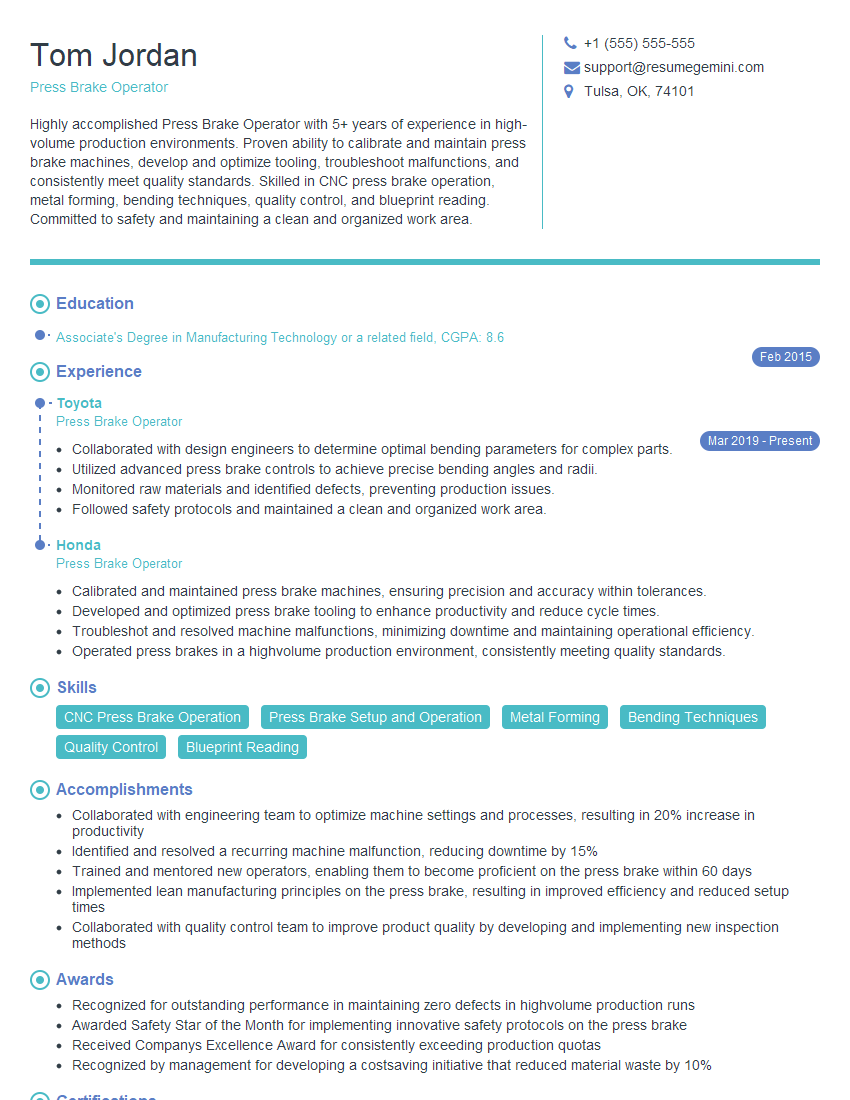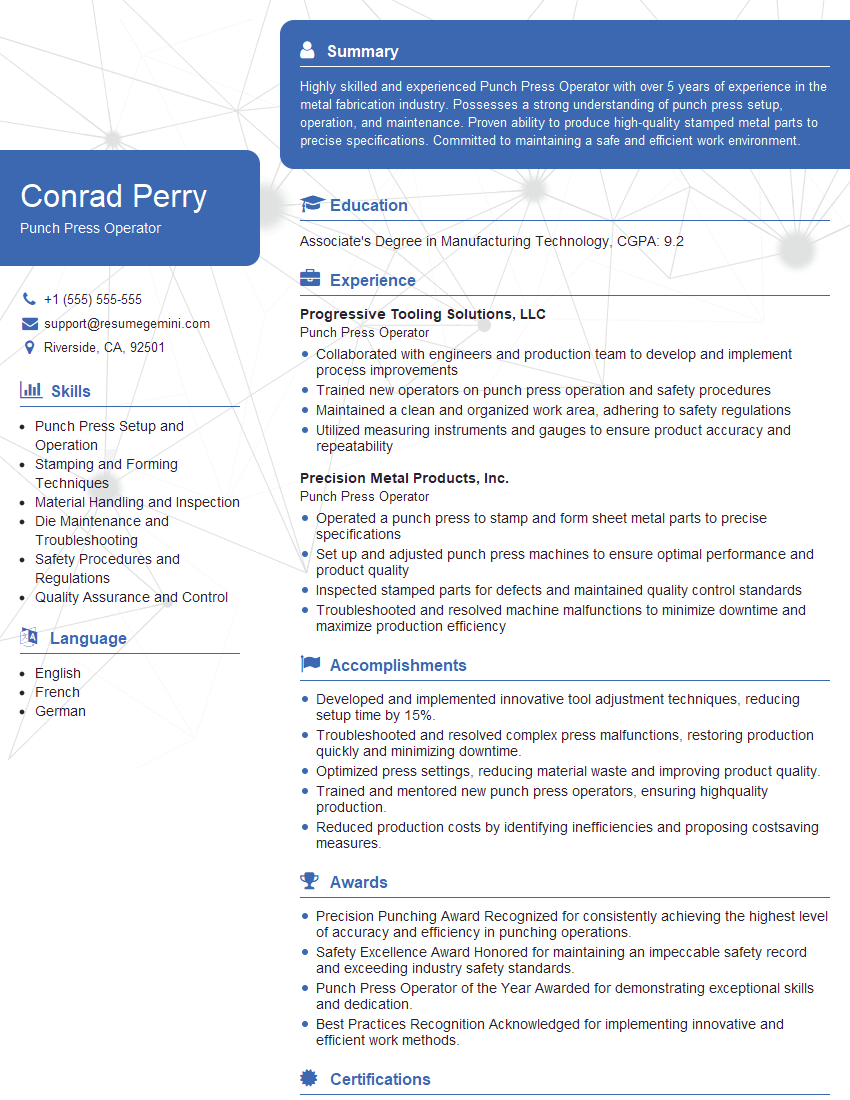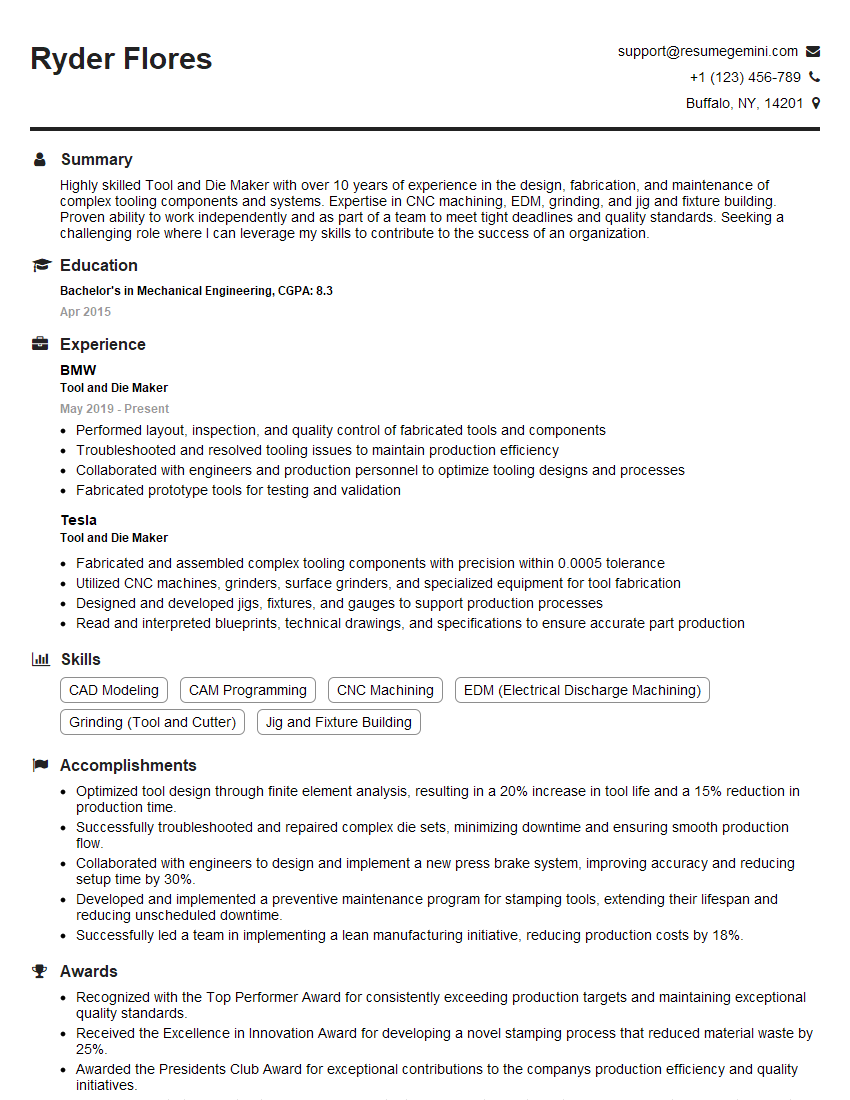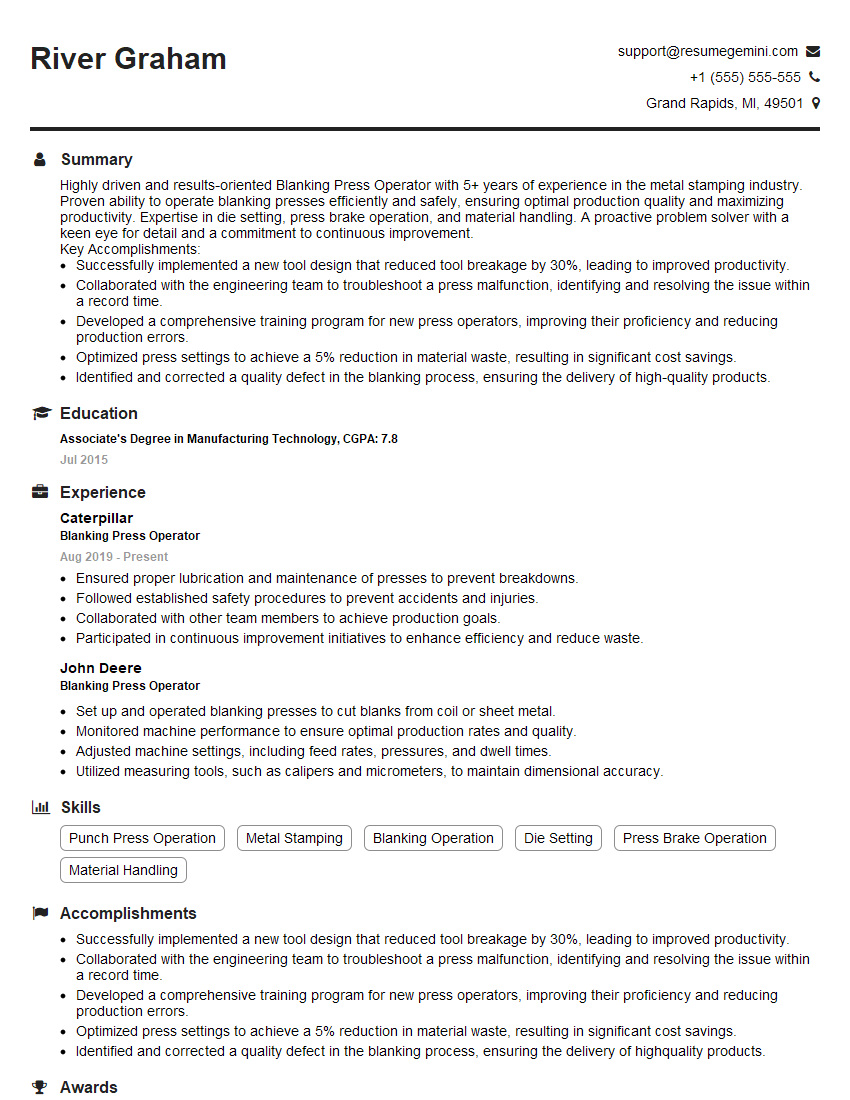Feeling uncertain about what to expect in your upcoming interview? We’ve got you covered! This blog highlights the most important Punching out blanks interview questions and provides actionable advice to help you stand out as the ideal candidate. Let’s pave the way for your success.
Questions Asked in Punching out blanks Interview
Q 1. What are the different types of punching dies used in blanking operations?
Punching dies for blanking operations are categorized based on their design and the type of blank they produce. Common types include:
- Single-stage dies: These dies perform the blanking operation in a single stroke. They’re simple and cost-effective but limited to simpler shapes.
- Progressive dies: These complex dies perform multiple operations (blanking, piercing, forming) in a single pass of the sheet material. This significantly increases production efficiency but requires more intricate die design and higher upfront costs. Imagine a single die making a complex part like a car door handle in one go.
- Compound dies: These dies perform two or more operations simultaneously (e.g., blanking and piercing) with one stroke. They are efficient but less flexible than progressive dies.
- Fine blanking dies: Used for achieving exceptionally tight tolerances and smooth edges. They utilize a special clamping system to minimize material deformation during blanking, ideal for parts needing precise dimensions.
- Shear dies: Instead of a straight cut, shear dies produce a slightly angled cut, which reduces burr formation. It’s often used when dealing with harder materials.
The choice of die type depends largely on factors such as the complexity of the part, the required tolerances, production volume, and material properties.
Q 2. Explain the process of setting up a punch press for blanking.
Setting up a punch press for blanking involves several crucial steps, ensuring both safety and precision:
- Die Installation: Carefully place the die set into the press, ensuring proper alignment and secure fastening. Incorrect alignment can lead to damaged dies and inaccurate blanks.
- Material Feeding: The coil or sheet metal is fed into the press via a feeder mechanism. Adjust the feeder to ensure consistent material flow and avoid wrinkles or misalignment.
- Die Height Adjustment: The die height is critical. It’s adjusted to ensure the punch and die are properly aligned and the sheet metal is sheared cleanly. Incorrect height will result in inconsistent blanks or damaged tooling.
- Stroke Adjustment: The press stroke is adjusted to ensure the punch completely penetrates the material. Insufficient stroke depth will result in incomplete blanks, while excessive stroke can damage the die.
- Safety Checks: A thorough safety check is essential before initiating operation. This includes checking guards, emergency stops, and lubrication.
- Test Run: A small test run is conducted to confirm the blanking process is operating correctly, checking for defects in the first few blanks before proceeding to full production.
Imagine building with LEGOs – each step needs precise positioning and alignment, otherwise the final structure is flawed. Setting up a punch press is similar; precision in each step results in flawless blanks.
Q 3. How do you ensure the accuracy and precision of punched blanks?
Accuracy and precision in punched blanks are paramount. Several methods ensure this:
- Precise Die Design and Manufacturing: Using advanced CAD/CAM techniques for die design and precision manufacturing processes are essential for accurate die dimensions and tolerances.
- Regular Die Maintenance and Inspection: Regular inspection and sharpening of the dies are critical in maintaining the accuracy of the blanks. Wear and tear can cause significant deviations from the intended dimensions.
- Material Selection and Handling: The material properties significantly influence the accuracy of the blanks. Using consistent quality materials and handling them carefully avoids introducing imperfections.
- Precise Machine Setup and Calibration: Regular calibration of the press ensures consistent force and stroke length, crucial for producing accurate blanks. A simple analogy is a weighing scale – if not calibrated, the weight readings will be inaccurate.
- Quality Control Checks: Continuous quality checks throughout the process, including dimensional inspection and visual examination, are indispensable in identifying and rectifying any issues.
Think of it like baking a cake – precise measurements and consistent baking temperatures are crucial for a perfect outcome. Similarly, in blanking, precision in every step is essential for the desired accuracy.
Q 4. Describe your experience with different types of materials used in blanking.
My experience encompasses a wide range of materials used in blanking, including:
- Mild Steel: A common material due to its affordability and workability. It’s suitable for many applications but may require specific die designs to mitigate burr formation.
- Stainless Steel: Offers excellent corrosion resistance but is more challenging to blank due to its higher strength and hardness. Specialized tooling and techniques are often required.
- Aluminum: Lightweight and easy to work with, it’s commonly used in the aerospace and automotive industries. It can be prone to tearing if not blanked correctly.
- Brass and Copper: These materials are used for applications requiring good electrical conductivity and corrosion resistance. Their ductility requires careful consideration of die design to prevent deformation.
- High-strength steel: Ideal for high-stress applications; however, it demands robust tooling and specialized techniques to prevent premature wear and breakage of dies. Fine blanking is often employed.
Each material presents unique challenges and requires tailored processing parameters and tooling to achieve the optimal results. The material choice depends on the final application and required properties of the blank.
Q 5. What are the common causes of defects in punched blanks, and how do you troubleshoot them?
Common defects in punched blanks and their troubleshooting include:
- Burrs: Caused by improper die clearance or dull tooling. Solution: Adjust die clearance or replace/sharpen the dies.
- Broken Blanks: Caused by excessive force, material defects, or improper die alignment. Solution: Reduce force, inspect material, or realign the dies.
- Misaligned Blanks: Caused by poor material feeding, die misalignment, or press malfunction. Solution: Adjust feeder, realign dies, and maintain the press.
- Cracking: Can result from excessive stress on the material during blanking or inherent material defects. Solution: Adjust blanking parameters (force, speed), check material quality and consider material change.
- Edge defects (e.g., tear): Occur due to the material’s properties, dull tooling, or insufficient hold-down force. Solution: Optimize die design, replace or sharpen tooling, and improve hold-down force.
Troubleshooting involves systematic investigation, starting with visual inspection, followed by analyzing the process parameters and inspecting the tooling. It’s a process of elimination to pinpoint the root cause.
Q 6. How do you maintain and inspect punching dies to ensure optimal performance?
Maintaining and inspecting punching dies is crucial for optimal performance and longevity. This includes:
- Regular Inspection: Dies should be inspected regularly for wear and tear, cracks, chips, and other damage. This is often done visually and can involve using measuring tools for precise dimensions.
- Sharpening and Resurfacing: Dull dies can cause defects and reduced accuracy. Regular sharpening and resurfacing restore the die’s cutting edge.
- Lubrication: Proper lubrication reduces friction and wear, increasing die life and improving the quality of blanks.
- Cleaning: Removing debris and metal chips prevents build-up that can interfere with the blanking process and damage the die.
- Storage: When not in use, dies should be stored properly to protect them from damage and corrosion.
Think of it as car maintenance – regular checks, servicing and cleaning extend its lifespan and ensure optimal performance. The same principle applies to punching dies; proactive maintenance prevents costly downtime and ensures consistent high-quality output.
Q 7. What safety precautions do you follow when operating a punch press?
Safety is paramount when operating a punch press. Key precautions include:
- Lockout/Tagout Procedures: Before any maintenance or repair, the press must be locked out and tagged out to prevent accidental activation.
- Proper Personal Protective Equipment (PPE): This includes safety glasses, hearing protection, and gloves to prevent injuries from flying debris, noise, and sharp edges.
- Machine Guards: Ensuring all safety guards are in place and functioning correctly prevents accidental contact with moving parts.
- Emergency Stop Procedures: Operators must be familiar with the location and operation of emergency stop buttons and understand proper procedures in case of a malfunction.
- Training and Competency: Operators must receive proper training on safe operation procedures before operating the punch press.
- Regular Inspections: The machine and its safety features should be regularly inspected to ensure they are in good working order.
Safety is not just a guideline but a fundamental principle. A moment’s lapse can have severe consequences. By strictly adhering to safety protocols, we ensure the wellbeing of ourselves and our colleagues.
Q 8. Explain your experience with different types of punch press controls (e.g., manual, CNC).
My experience spans a wide range of punch press controls, from basic manual presses to sophisticated CNC (Computer Numerical Control) systems. Manual presses offer hands-on control, ideal for small-batch production or intricate setups requiring precise adjustments. However, they are significantly slower and more labor-intensive. I’ve extensively used them for prototype work and small-scale projects where flexibility is key.
CNC systems, on the other hand, are the workhorses for high-volume, consistent production. I’m proficient in programming and operating various CNC systems, including those utilizing Fanuc, Siemens, and Allen-Bradley controls. The advantage is unparalleled speed, accuracy, and repeatability, enabling precise blanking of complex shapes with minimal variation. My experience includes setting up tool offsets, writing and optimizing CNC programs (G-code), and troubleshooting potential issues. I’m also comfortable working with automated feeding and unloading systems integrated with CNC presses.
For instance, I recently optimized a CNC program for a customer requiring 10,000 blanks per hour. By refining the feed rate and tool path, I increased production by 15% while maintaining consistent dimensional accuracy. The switch to CNC, in that case, dramatically boosted efficiency and reduced human error.
Q 9. How do you calculate the required tonnage for a specific blanking operation?
Calculating the required tonnage for a blanking operation involves considering several factors. The primary calculation revolves around the shear strength of the material and the length of the cut. The formula often used is:
Tonnage = (Shear Strength) * (Sheared Length) * (Thickness)Where:
- Shear Strength: This is a material property found in material datasheets and varies significantly depending on the material (e.g., steel, aluminum, brass). It represents the force required to shear a unit area of the material.
- Sheared Length: This is the total length of the perimeter of the blank being punched. For complex shapes, this might require breaking down the shape into simpler geometric forms to calculate the total perimeter.
- Thickness: The thickness of the sheet metal being processed.
However, this formula provides a theoretical minimum. Practical considerations necessitate adding a safety factor (typically 10-20%) to account for friction, die wear, and other variables. Furthermore, the press must have sufficient capacity to handle the force exerted during the operation. Factors like the blank shape (sharp corners require more force) and material condition (work hardening) also influence the actual tonnage required. I always prefer to err on the side of caution, selecting a press with higher tonnage capacity than the bare minimum calculation.
Example: Let’s say we are punching a square blank from mild steel. Shear strength is 60,000 psi, the sheared length (4 sides of 2 inches each) is 8 inches, and the material thickness is 0.125 inches. The theoretical tonnage would be (60,000 psi * 8 in * 0.125 in) = 60,000 lbs. A 20% safety factor would lead to selecting a press with at least 72,000 lbs capacity.
Q 10. How do you determine the optimal speed and feed rate for a punching operation?
Determining the optimal speed and feed rate for punching operations is a balancing act between productivity and quality. High speeds increase production but can lead to increased wear on the dies, reduced accuracy, and potentially even material damage. Conversely, low speeds improve quality and die life but reduce throughput. Several factors influence this decision:
- Material Type and Thickness: Thicker and harder materials require lower speeds and feed rates to prevent die breakage or excessive deformation.
- Die Design: The complexity of the die and its tolerances impact the appropriate speed. More intricate dies usually benefit from slower speeds.
- Press Capacity: The press’s capabilities, particularly its tonnage and stroke rate, also dictate realistic speed and feed rate limits.
- Desired Accuracy: If tight tolerances are crucial, slower speeds will be necessary to ensure dimensional accuracy and surface finish quality.
I typically start with conservative settings and gradually increase speed and feed rate while closely monitoring the quality of the punched blanks. Regular inspection helps to identify any signs of degradation, such as burrs, cracks, or dimensional inaccuracies. Data logging from the CNC machine also provides invaluable information to optimize the process over time. For example, I might run a small test batch at various speeds to determine the optimal speed while maintaining quality standards within a tolerance of 0.005 inches, then scale up the production accordingly.
Q 11. What is your experience with different types of lubrication for punch press dies?
The choice of lubrication for punch press dies is crucial for maximizing die life, preventing premature wear, and ensuring consistent quality. My experience involves various lubrication methods, each with its advantages and disadvantages:
- Water-based lubricants: These are environmentally friendly and relatively inexpensive. However, they may not offer the same level of lubrication as oil-based solutions, leading to slightly increased wear, especially with harder materials.
- Oil-based lubricants: These provide superior lubrication and reduce friction. However, they can be messy, require careful disposal, and may not be suitable for all materials or environments.
- Dry lubricants: These include materials like graphite or molybdenum disulfide applied as a powder or coating. They are beneficial where oil contamination is unacceptable, but they might not be as effective as liquid lubricants in heavy-duty applications.
The selection depends heavily on the specific application. For instance, a high-volume production run with aluminum might use a water-based lubricant, whereas high-strength steel might require an oil-based lubricant with extreme-pressure additives. In some cases, a combination of methods is employed. Regular monitoring of the lubricant’s condition and its application to the die is key to prevent wear and tear. I also ensure that the lubricant is compatible with the material being processed to prevent adverse reactions or staining.
Q 12. How do you handle material jams or other production stoppages?
Handling material jams or production stoppages efficiently requires a systematic approach. The first step involves identifying the root cause. This might involve inspecting the material feed system for obstructions, checking the die for damage or misalignment, or investigating whether there’s an issue with the press’s mechanical components.
Common causes include:
- Material defects: Variations in material thickness or surface imperfections can lead to jams.
- Die issues: Wear, damage, or improper alignment can cause the material to bind.
- Feeding system problems: Malfunctioning feeders or incorrect settings can result in material bunching or misalignment.
- Mechanical failures: Problems with the press itself might lead to interruptions.
Once the cause is identified, I take corrective action. This might involve clearing the jam, replacing a damaged component (like a worn punch or die), repairing a malfunctioning feeder, or adjusting press settings. Preventing future stoppages involves implementing preventive maintenance schedules, regularly inspecting the equipment, and ensuring proper material handling procedures are followed. A well-maintained press and diligent operator attention are critical for minimizing downtime.
Q 13. Describe your experience with quality control procedures for punched blanks.
Quality control for punched blanks involves a multi-stage process ensuring dimensional accuracy, surface finish, and overall conformity to specifications. This usually involves:
- Visual Inspection: A visual check for burrs, scratches, cracks, or other surface defects.
- Dimensional Measurement: Using precision measuring instruments (calipers, micrometers, CMMs) to verify that the blanks meet the specified dimensions within defined tolerances.
- Statistical Process Control (SPC): Implementing SPC charts to monitor key process parameters and identify any trends that might indicate a problem developing.
- Random Sampling: Regularly sampling the punched blanks and subjecting them to rigorous testing to ensure consistent quality across the whole batch.
I have experience implementing and maintaining quality control procedures based on industry standards like ISO 9001. Documentation is crucial—recording inspection results, maintaining calibration records for measuring instruments, and documenting corrective actions. This ensures traceability and aids in continuous improvement of the punching process. For instance, I might set up control charts monitoring the thickness of the blanks produced throughout the run to quickly spot any deviations and make necessary adjustments to the process.
Q 14. What is your experience with using measuring instruments to verify the dimensions of punched blanks?
I’m proficient in using a variety of measuring instruments to verify the dimensions of punched blanks, ensuring adherence to specifications and quality standards. My experience includes:
- Calipers: For measuring outside dimensions and various features with reasonable accuracy.
- Micrometers: For higher-precision measurements of thickness and smaller dimensions.
- Coordinate Measuring Machines (CMMs): These advanced instruments provide highly precise measurements of complex shapes and allow for automated data collection.
- Optical Comparators: Useful for verifying the shape and overall profile of the blanks against a master template.
Choosing the right instrument depends on the specific dimension being measured and the required precision. Proper calibration and technique are crucial to ensure accuracy. I always adhere to established calibration procedures and maintain detailed records. For instance, I would use a CMM for checking intricate shapes with tight tolerances, while calipers are sufficient for basic dimensional checks on simpler blanks. Each instrument’s limitations are understood, and measurements are always performed carefully and documented meticulously.
Q 15. How do you manage and dispose of scrap materials from the blanking process?
Scrap management in blanking is crucial for both environmental responsibility and economic efficiency. We employ a multi-pronged approach. First, careful die design minimizes scrap generation. Second, we use scrap chutes and conveyors to efficiently collect and separate different scrap types (e.g., slugs, edge trim). Third, we meticulously sort scrap materials – often by metal type and grade – to maximize their recyclability. This allows us to sell it back to metal suppliers or use it internally for other processes. Finally, we maintain detailed records of scrap generation to identify areas for improvement and to comply with environmental regulations. For example, in one project involving stainless steel blanking, we redesigned the blank shape to reduce waste by 15%, significantly improving our bottom line and reducing our carbon footprint.
Career Expert Tips:
- Ace those interviews! Prepare effectively by reviewing the Top 50 Most Common Interview Questions on ResumeGemini.
- Navigate your job search with confidence! Explore a wide range of Career Tips on ResumeGemini. Learn about common challenges and recommendations to overcome them.
- Craft the perfect resume! Master the Art of Resume Writing with ResumeGemini’s guide. Showcase your unique qualifications and achievements effectively.
- Don’t miss out on holiday savings! Build your dream resume with ResumeGemini’s ATS optimized templates.
Q 16. What is your understanding of the relationship between die design and blank quality?
Die design is paramount to blank quality. A poorly designed die can lead to a cascade of problems including burrs, tears, inconsistent dimensions, and surface imperfections. For instance, the sharpness of the cutting edges directly impacts the blank’s surface finish. A dull or damaged punch can cause excessive burring and material deformation, while inadequate clearance between punch and die can lead to excessive friction and tearing. Proper material flow within the die needs consideration. The design should ensure consistent material flow across the entire blank, preventing uneven thickness or strain. Finite element analysis (FEA) simulations are often used in modern die design to predict and optimize the material flow and stress distribution, minimizing defects. Think of it like baking a cake; the right pan and oven settings (die design) determine the quality of the final product (blank).
Q 17. How do you handle different metal thicknesses and material properties during blanking?
Handling different metal thicknesses and material properties requires adaptability and precision. Thicker materials require more force and potentially different die designs (e.g., stronger punches and dies, more robust press). Brittle materials need slower press speeds and perhaps specialized lubricants to avoid cracking or shattering. Ductile materials, on the other hand, might require more attention to prevent excessive deformation. We adjust press parameters (speed, tonnage) and sometimes utilize specialized tooling or lubricants depending on the material. For example, when blanking high-strength steel, we use progressive dies and a slower press speed to ensure clean cuts and minimize risk of cracks. For thinner materials, such as aluminum, we focus on reducing punch and die wear to prevent edge deformation and maintain tighter tolerances.
Q 18. Describe your experience with preventative maintenance on punch presses.
Preventative maintenance is non-negotiable for punch press longevity and safety. Our program involves regular lubrication of moving parts, scheduled inspections of critical components (e.g., bearings, slides, clutches), and periodic functional tests. We meticulously track press usage and performance data to identify potential issues before they lead to failures. We adhere to a strict preventative maintenance schedule defined by manufacturer recommendations and our own internal experience. This often involves using vibration analysis and other predictive maintenance techniques. For example, regularly checking and replacing worn-out die cushions can prevent unexpected press downtime and damage to the die set. Proactive maintenance saves us significant downtime and repair costs in the long run.
Q 19. What are the common causes of die wear and tear, and how do you mitigate them?
Die wear and tear is inevitable, but its rate can be significantly slowed. Common causes include: abrasion from repeated metal cutting, fatigue from cyclic loading, and impact from poorly controlled material flow. We mitigate these through careful selection of die materials (e.g., hardened tool steels), proper lubrication, and regular sharpening or replacement of worn components. Maintaining consistent material properties (thickness, hardness) of the incoming sheet metal is vital, as inconsistent materials put uneven stress on the die. Furthermore, monitoring the press for signs of excessive vibration or noise can indicate impending die failure. Regular inspection and preventative maintenance are crucial for extending the life of our dies.
Q 20. Explain your understanding of the importance of proper die alignment in blanking.
Proper die alignment is fundamental to accurate blanking. Misalignment leads to off-center punches, resulting in scrapped parts, inconsistent dimensions, and potentially damaged tooling. We employ precision alignment techniques during die setup, using optical tools or laser alignment systems to ensure the punch and die are perfectly concentric. Any deviation can result in significant waste and quality issues. Imagine trying to punch a hole in a piece of paper with two misaligned punches – the result would be far from a clean, precise hole. The same principle applies to industrial blanking. Precision alignment ensures the quality and consistency of the final products. Regular checking for alignment throughout the production run is a crucial part of quality control.
Q 21. How do you calculate the cost-effectiveness of different blanking methods?
Cost-effectiveness involves a comprehensive analysis of different blanking methods. This includes considering factors like initial die cost, tooling maintenance, material waste, labor costs, production speed, and energy consumption. We carefully evaluate different methods such as single-stage, progressive, or compound dies, comparing their respective costs per part. Furthermore, we quantify the impact of factors like scrap rate and machine downtime on the overall cost. A detailed cost analysis allows for informed decisions regarding investment in new tooling or processes, ensuring optimal efficiency and profitability. For instance, while progressive dies have a higher upfront cost, their increased production speed can significantly reduce per-part costs for high-volume production.
Q 22. How do you ensure the safety of yourself and your coworkers during punching operations?
Safety is paramount in punching operations. My approach is multifaceted, starting with rigorous adherence to established safety protocols. This includes mandatory PPE (Personal Protective Equipment) like safety glasses, hearing protection, and steel-toed boots. Before every operation, I conduct a thorough machine inspection, checking for loose parts, proper lubrication, and ensuring all safety guards are securely in place and functioning correctly. Furthermore, I’m vigilant about maintaining a clean and organized workspace, minimizing trip hazards and ensuring clear pathways. I actively participate in safety training and encourage my colleagues to do the same, fostering a culture of mutual responsibility and reporting any potential hazards immediately. For example, if I notice a worn-out die, I immediately report it and remove it from service to prevent accidents. Finally, I always follow the lock-out/tag-out procedure when performing maintenance or repairs on the press, ensuring the machine is completely de-energized before any work begins.
Q 23. Describe your experience with different types of press guarding and safety equipment.
My experience encompasses various press guarding systems, from basic fixed guards to more sophisticated light curtains and interlocked safety systems. I’m familiar with different types of guards including barrier guards (physical barriers preventing access to the danger zone), presence-sensing devices (light curtains or pressure mats that detect operator presence), and two-hand control systems (requiring the operator to use both hands to initiate the press cycle). I’ve worked extensively with light curtains, which offer a non-contact method to protect operators. Their effectiveness is dependent on proper alignment and regular maintenance. Furthermore, I’m experienced in using automated safety systems, including robotic systems equipped with advanced safety features such as emergency stop buttons and speed reduction systems for collaborative robots. In one instance, I helped to implement a new light curtain system, replacing an older, less reliable barrier guard, resulting in a significant improvement in operator safety and a reduction in downtime due to accidental stops.
Q 24. What are your strategies for optimizing production efficiency in a blanking operation?
Optimizing blanking production efficiency involves a holistic approach. It begins with thorough process planning, selecting the right tooling, and optimizing the die design for the specific blank shape. For example, selecting a progressive die for high-volume production of simple shapes is significantly more efficient than using a single-stage die. Careful material selection plays a crucial role; using a material with appropriate properties for punching minimizes scrap and ensures consistent product quality. Furthermore, regularly scheduled machine maintenance is vital to prevent downtime and maintain optimal operating speed and accuracy. We also use lean manufacturing principles, minimizing waste and optimizing workflow. This includes efficient material handling and storage strategies. Continuous monitoring of key performance indicators (KPIs), such as cycle time, scrap rate, and overall equipment effectiveness (OEE), provides valuable feedback for process improvement. For instance, by implementing a new material handling system, we reduced our material handling time by 15%, directly improving overall production efficiency.
Q 25. Explain your understanding of different types of blank shapes and their production methods.
Blanking produces a wide range of shapes, from simple circles and squares to complex contours. Production methods vary depending on the complexity of the shape and production volume. Simple shapes are often produced using progressive dies, which perform multiple operations in a single stroke. For more complex shapes, compound or tandem dies may be required, involving multiple stages and potentially requiring additional equipment such as transfer presses. For low-volume production, single-stage dies are often used for flexibility in shape modification. The choice of die depends greatly on the shape’s geometry and tolerance requirements. For instance, a circular blank is readily produced with a simple punch and die, while a complex automotive part requires a sophisticated multi-stage die. Accurate die design is crucial for ensuring precise blank dimensions and minimizing scrap. I have experience using a variety of CAD software to create and analyze die designs for diverse blank shapes, ensuring optimal efficiency and quality.
Q 26. What is your experience with automated systems used in blanking (e.g., robotic systems)?
I have significant experience with automated systems in blanking, particularly robotic systems for material handling and part removal. Robotic systems improve safety by removing operators from the immediate vicinity of the press during operation. They also enhance productivity through consistent and faster cycle times and reduced operator fatigue. I’ve worked with various robotic systems including six-axis articulated robots and SCARA robots, each with its own advantages depending on the application. For example, a six-axis robot provides greater flexibility in handling complex parts, while a SCARA robot is efficient for simpler pick-and-place operations. Integrating robotic systems requires careful planning and programming to ensure seamless operation and coordination with the press itself. This includes the use of appropriate sensors and safety interlocks to guarantee safe operation. In a recent project, we implemented a robotic system to automate the removal of blanks from a high-speed press, resulting in a 20% increase in production output and a noticeable reduction in operator fatigue.
Q 27. How do you adapt to changes in production requirements or material specifications?
Adapting to changes in production requirements or material specifications is a core competency. This involves a systematic approach that begins with careful review of the changes and their implications. We assess the impact on the existing tooling, processes, and equipment. Sometimes minor adjustments to the tooling or press settings are sufficient. In other cases, we may need to design and manufacture new tooling, adjust material handling procedures, or even invest in new equipment. For example, if the material specification changes from mild steel to stainless steel, we need to recalibrate the press parameters to account for the different material properties and potentially select a new die material for better wear resistance. We might also need to adjust our lubrication strategy. Continuous communication with engineering, production planning, and quality control is crucial throughout this adaptation process. In one situation, we transitioned to a new material with improved strength, requiring modification of the press parameters and tooling but resulting in improved part quality and a reduction in scrap.
Key Topics to Learn for Punching out Blanks Interview
- Die Design and Selection: Understanding the different types of dies used in punching out blanks, their strengths and weaknesses, and how to select the appropriate die for a given application. Consider factors like material thickness, shape complexity, and production volume.
- Material Properties and Considerations: Knowing how different materials (metals, plastics, etc.) behave under pressure and how this impacts die design and the punching process. This includes understanding material yield strength, ductility, and potential for defects like burrs or cracks.
- Punching Press Operation and Maintenance: Familiarity with the mechanics of punching presses, including different press types, safety procedures, and routine maintenance tasks. Understanding the role of lubrication and proper tool alignment is crucial.
- Tooling and Fixture Design: Exploring the design and functionality of punches, dies, and associated tooling components. Understanding the principles of die construction, including stripper plates, guide bushings, and ejectors.
- Quality Control and Inspection: Implementing methods to ensure the quality of punched blanks, including dimensional inspection, surface finish evaluation, and defect detection. Understanding statistical process control (SPC) techniques is beneficial.
- Troubleshooting and Problem Solving: Developing the ability to diagnose and resolve common issues encountered during the punching process, such as broken tools, material defects, and dimensional inaccuracies. This includes understanding root cause analysis techniques.
- Safety Procedures and Regulations: A thorough understanding of all safety protocols and regulations related to operating punching presses and handling associated tooling. This is paramount for a safe and productive work environment.
Next Steps
Mastering the intricacies of punching out blanks is vital for career advancement in manufacturing and related fields. A strong understanding of this process demonstrates practical skills and problem-solving abilities highly valued by employers. To maximize your job prospects, crafting an ATS-friendly resume is crucial. ResumeGemini is a trusted resource that can help you build a professional and impactful resume tailored to highlight your expertise in punching out blanks. Examples of resumes tailored to this field are available to guide you through the process.
Explore more articles
Users Rating of Our Blogs
Share Your Experience
We value your feedback! Please rate our content and share your thoughts (optional).
What Readers Say About Our Blog
Hello,
We found issues with your domain’s email setup that may be sending your messages to spam or blocking them completely. InboxShield Mini shows you how to fix it in minutes — no tech skills required.
Scan your domain now for details: https://inboxshield-mini.com/
— Adam @ InboxShield Mini
Reply STOP to unsubscribe
Hi, are you owner of interviewgemini.com? What if I told you I could help you find extra time in your schedule, reconnect with leads you didn’t even realize you missed, and bring in more “I want to work with you” conversations, without increasing your ad spend or hiring a full-time employee?
All with a flexible, budget-friendly service that could easily pay for itself. Sounds good?
Would it be nice to jump on a quick 10-minute call so I can show you exactly how we make this work?
Best,
Hapei
Marketing Director
Hey, I know you’re the owner of interviewgemini.com. I’ll be quick.
Fundraising for your business is tough and time-consuming. We make it easier by guaranteeing two private investor meetings each month, for six months. No demos, no pitch events – just direct introductions to active investors matched to your startup.
If youR17;re raising, this could help you build real momentum. Want me to send more info?
Hi, I represent an SEO company that specialises in getting you AI citations and higher rankings on Google. I’d like to offer you a 100% free SEO audit for your website. Would you be interested?
Hi, I represent an SEO company that specialises in getting you AI citations and higher rankings on Google. I’d like to offer you a 100% free SEO audit for your website. Would you be interested?
good
